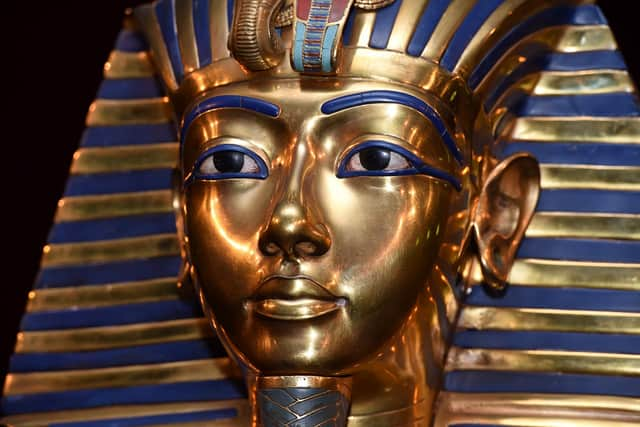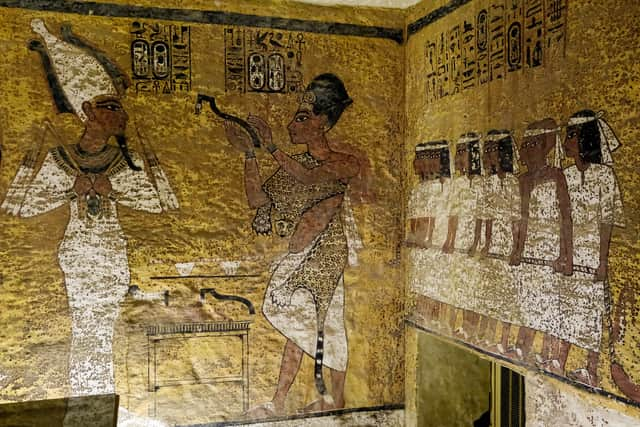Tutankhamun: how old was King Tut when he died, where is KV62, what was found in tomb, why is he so famous?
and live on Freeview channel 276
It’s officially been one hundred years since the discovery of King Tutankhamun’s tomb in Egypt. Dubbed the “Boy King”, the pharaoh’s tomb was discovered in the Valley of the Kings in 1922 by British archaeologist Howard Carter.
Tutankhamun’s tomb is the only royal burial chamber to be found intact, with archaeologists able to learn vital information about Ancient Egypt and the process of mumification.
Advertisement
Hide AdAdvertisement
Hide AdThe pharaoh’s mummy can still be seen today and remains on display within his tomb in the KV62 chamber at the Valley of the Kings, Luxor along with his burial mask and layered coffin.
King Tut’s discovery sparked a facination with Ancient Egypt that influenced the roaring twenties. Rumours of the curse of the pharaoh that caused the death of those who discovered his tomb was rife in the media at the time.
But who was the young pharaoh, how old was he when died and why is he so famous? Here’s everything you need to know.


How old was King Tut when he died?
King Tutankhamun, often known as King Tut was just 19-years-old when he died in around 1324 B.C. The young pharaoh ruled for just 10 years after coming to power when he was 9-years-old, with his youthful reign earning him the nickname the boy king.
Advertisement
Hide AdAdvertisement
Hide AdHe was unknown to the modern world until his tomb was discovered by British archaeologist Howard Carter, who discovered a treasure trove of undisturbed artefacts that had been untouched for 3,000 years. The discovery and the media hype that surrounded it made him the world’s most famous pharaoh and influenced fashion and design of the roaring twenties.
Where is KV62?
The pharaoh’s tomb was discovered in the Valley of the Kings in Luxor, Egypt. It is called KV62, which stands for King’s Valley and 62 because it was the 62nd burial chamber discovered there. The interior of the tomb is open to members of the public.


What was found in the tomb?
Tutankhamen’s tomb was the only royal burial chamber to have ever been discovered intact. Carter and his team discovered a treasure trove of artefacts untouched for more than 3,000 years.
The tomb included the king’s coffin, made of solid gold which contained his mummified remains, golden shrines, jewellery, statues, a chariot, weapons and his clothes.
Why is he so famous?
Advertisement
Hide AdAdvertisement
Hide AdTutankhamun is so famous because his tomb is the only royal burial chamber that has ever been found complete. The discovery helped archaeologists learn about Ancient Egypt and the process of mummification.
It was also heavily publicised in the media with news of the discovery of his tomb and the rumoured curse of the pharaohs captivating audiences around the world.
What was the curse of the pharaohs?
Following the discovery there was rife speculation in the press that those who had uncovered the tomb would be met with a deadly curse.
HistoryToday explains that newspapers including The Times and the New York World published extracts of the best-selling novel by Marie Corelli that speculated that: “the most dire punishment follows any rash intruder into a sealed tomb.”
Advertisement
Hide AdAdvertisement
Hide AdOne of the explorers, Lord Carnarvon, who was patron of Howard Carter’s archaeological excavations died five months after the discovery, whilst others alleged to have fallen victim of the curse include: Prince Ali Kamel Fahmy Bey of Egypt who was shot dead by his wife in 1923, Sir Archibald Douglas Reid, who is believed to have x-rayed the mummy and died mysteriously in 1924, Sir Lee Stack, the governor-general of Sudan, who was assassinated in Cairo in 1924, Arthur Mace a member of the excavation team who died from suspected poisoning in 1928 and Carter’s secretary Richard Bethell, who was found dead in his bed following mysterious circumstances in 1929.
Comment Guidelines
National World encourages reader discussion on our stories. User feedback, insights and back-and-forth exchanges add a rich layer of context to reporting. Please review our Community Guidelines before commenting.
